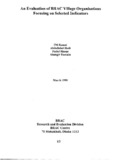| dc.identifier.citation | Kamal, F., Hadi, A., Hauqe, F., & Hussain, A. (1998, March). An evaluation of BRAC village organisations: focusing on selected indicators. Research Reports (1998): Social Studies, Vol – XVIII, 83–109. | en_US |
| dc.description.abstract | 1. The study was based on a conceptual premise that BRAC's credit-plus approach not only helps
improve economic condition of the rural poor by disbursing loan, but its group formation,
conscietisation, skill training and other educative and developmental components help generate
attitudinal changes towards a socio-economic transition. In such context BRAC's villagae
organisation (VO) has been hypothesized as a conduit.
2. The study had the following objectives: a). to explore what proportion of VOs follow the stimulated
norms, b). to know the differentials of regular and irregular VOs, and c). to examine how the regular
members differ from irregular members in respect to perception of well-being, economic status,
observance of VO norms and other selected criteria.
3. The study had two units of analysis: the VO and the individual member. The VOs formed in years
from 1986 to 1995 are taken as the study population. A total of 240 VOs from 18 RDP regions were
selected by a stratified random sampling technique. From each VO, 2 regular and 2 irregular YO
member were selected randomly.
4. A pretested semi-structured questionnaire and a direct observation checklist were used for data
collection. The questionnaire was used to conduct interviews with individual YO members and the
direct observational data on YO meetings were collected through a checklist.
5. About 68 percent of the YO members are illiterate. Only 9.3 percent have above primary literacy.
About 88 percent of the VO members are Muslim and 12 percent are Hindu.
6. Of the VOs, 51.5 percent adopt resolutions in meetings, 16.3 percent ring bell, 36.0 percent start
meeting in time, 74.5 percent recite 18 points, 43.5 percent have small groups, 42.7 percent follow
proper, sitting arrangement and 19.2 percent follow appropriate loan reimbursement process. There
exist significant regional variation in observance of these norms. The year of YO formation has also
significant impact on observance of the VO norms.
7. About 74 percent of the VOW members have land less than 50 decimals, about 20 percent 50-199
decimals and 6. 7 percent more 200 decimals.
8. Most members joined BRAC for financial benefits. For them, saving facilities, educational
opportunities for children, better seeds for cultivation and job opportunities are other issues of
attraction.
9. The knowledge of VO members about head of small group and his responsibility, after fluctuations
in the early years, consistently improves among recent VO members. Such knowledge is
significantly higher among regular VO members.
10. Age and education of the YO members and the year of receiving first loan have no impact on
regularity of the YO members.
11. The feeling of economic well-being among the YO members slowly but persistently improves by
year of joining BRAC. But those who perceive that their economy has been declining maintains
more or less the same trend irrespective of year of joining 12. Like peception of economic well-being, the surplus household economy is comparatively higher
among members those who joined BRAC in recent years, after 1993 . The proportion of those who
have no surplus or deficit economy represent about one-third of all VO members, and does not vary
with the year of joining BRAC. The surplus economy of the household very significantly depends on
regularity of the member.
13. The length of BRAC involvement has no significant impact on receiving modem method of medical
treatment for household members.
14. Lack of money for loan repayment, sickness, inhibition from husband and family members,
inappropriate behaviour from BRAC staff are important causes of absence from VO meetings.
15. Tendency to leave BRAC, lack of cash money, less income and hindrance from husband are common
causes of non-payment of weekly savings.
16. Eighteen percent of the VO members are also member of other NGOs. Both membership and credit
involvement follow more or less the same trend over the years from 1986 to 1995.
17. VO members, irrespective of year of joining BRAC, show comparatively higher loan repayment rate
than savings. However, both the weekly saving and the loan repayment rate followed the same trend
in the study period.
18. About 37 percent of the VOs had 40 percent or less attendance rate and 33.1 percent had 41-60
percent attendance rate. More than 60 attendance rate are observed in 30 percent of the VOs.
19. In about 32 percent of the VOs, the weekly savings deposit rate is 60 percent or less, and it is 61 - 80
percent in about 32 percent of VOs. More than 80 percent savings deposit rate is found in 45.2
percent of the VOs.
20. The loan repayment rate of 60 percent or less are found in 16.3 percent of VOs. The rate is 61-80
percent in 18.8 percent of the VOs. More than 80 percent repayment rate are found in 64.9 percent
of the VOs.
21. While asked how to remove existing weakness of the VO, 22.3 percent of the suggestions favoured
removal of pressurization of the members for loan repayment. Motivating husbands towards BRAC
were suggested in 3. 7 percent of the replies. Surprisingly, 74 percent of the answers did not contain
any specific suggestion.
22. Among irregular VO members, irrespective of year of joining BRAC, loan repayment rate is
comparatively higher than weekly savings. Both repayment and savings show the same trend of
relationship with the year of joining BRAC. | en_US |

